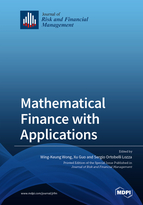Mathematical Finance with Applications
A special issue of Journal of Risk and Financial Management (ISSN 1911-8074). This special issue belongs to the section "Mathematics and Finance".
Deadline for manuscript submissions: closed (30 June 2020) | Viewed by 82329
Special Issue Editors
2. Department of Medical Research, China Medical University Hospital, Taichung City 40447, Taiwan
3. Department of Economics and Finance, The Hang Seng University of Hong Kong, Hong Kong, China
Interests: behavioral models; mathematical modeling; econometrics; energy economics; equity analysis; investment theory; risk management; behavioral economics; operational research; decision theory; environmental economics; public health; time series analysis; forecasting
Special Issues, Collections and Topics in MDPI journals
2. Assistant Research Professor, Department of Statistics, Penn State University, State College, PA, USA
Interests: model checking; missing data; high-dimensional data; decision making under uncertainty
Special Issue Information
Dear Colleagues,
Mathematical finance plays a vital role in many fields within finance and provides the theories and tools that have been widely used in all areas of finance.
Knowledge of mathematics, probability, and statistics is essential to develop finance theories and test their validity through the analysis of empirical, real-world data. For example, mathematics, probability, and statistics could help to develop pricing models for financial assets such as equities, bonds, currencies, and derivative securities.
This Special Issue on ‘Mathematical Finance with Applications’, edited by Xu Guo, Sergio Ortobelli, and Wing Keung Wong, will be devoted to related advancements in different areas of finance. The Special Issue will also bring together practical, state-of-the-art applications of mathematics, probability, and statistical techniques in finance.
We invite investigators to contribute original research articles that advance the use of mathematics, probability, and statistics in all areas of finance. All submissions must contain original unpublished work not being considered for publication elsewhere.
Topics of interest include, but are not limited to:
- Asset pricing and factor models
- Portfolio optimization
- Derivative valuation techniques
- Credit risk and credit rating
- Numerical and statistical approximation of stochastic differential equations with applications in finance
- Automated trading systems
- Statistical arbitrage
- Financial applications of computational intelligent (neural, fuzzy or evolutionary) methods
- Behavioral finance
- Estimation and forecasting of financial time series.
- Econometric and computational models for risk and financial analysis
Prof. Dr. Wing-Keung Wong
Prof. Dr. Sergio Ortobelli Lozza
Dr. Xu Guo
Guest Editors
Manuscript Submission Information
Manuscripts should be submitted online at www.mdpi.com by registering and logging in to this website. Once you are registered, click here to go to the submission form. Manuscripts can be submitted until the deadline. All submissions that pass pre-check are peer-reviewed. Accepted papers will be published continuously in the journal (as soon as accepted) and will be listed together on the special issue website. Research articles, review articles as well as short communications are invited. For planned papers, a title and short abstract (about 100 words) can be sent to the Editorial Office for announcement on this website.
Submitted manuscripts should not have been published previously, nor be under consideration for publication elsewhere (except conference proceedings papers). All manuscripts are thoroughly refereed through a single-blind peer-review process. A guide for authors and other relevant information for submission of manuscripts is available on the Instructions for Authors page. Journal of Risk and Financial Management is an international peer-reviewed open access monthly journal published by MDPI.
Please visit the Instructions for Authors page before submitting a manuscript. The Article Processing Charge (APC) for publication in this open access journal is 1400 CHF (Swiss Francs). Submitted papers should be well formatted and use good English. Authors may use MDPI's English editing service prior to publication or during author revisions.
Benefits of Publishing in a Special Issue
- Ease of navigation: Grouping papers by topic helps scholars navigate broad scope journals more efficiently.
- Greater discoverability: Special Issues support the reach and impact of scientific research. Articles in Special Issues are more discoverable and cited more frequently.
- Expansion of research network: Special Issues facilitate connections among authors, fostering scientific collaborations.
- External promotion: Articles in Special Issues are often promoted through the journal's social media, increasing their visibility.
- Reprint: MDPI Books provides the opportunity to republish successful Special Issues in book format, both online and in print.
Further information on MDPI's Special Issue policies can be found here.







